
World AIDS Day reminds us that 40 years since the first AIDS cases were reported, HIV remains a public health threat. Today, the world is off track from delivering on the shared global goal to end HIV/AIDS by 2030….CONTINUE READING
Despite the huge progress and advances in science, human rights, and public health investment achieved in the past four decades, structural inequalities still obstruct proven solutions to HIV prevention and treatment. To date, more than 84 million people have acquired HIV, 40 million people have died, and around 38.5 million worldwide live with HIV—the vast scale of the HIV pandemic remains.
N ew HIV infections have not declined fast enough
In 2016, the UN General Assembly set a global target to end HIV as a public health threat by 2030 by reducing HIV incidence by 75% by 2020 and by 90% by 2030 (compared to incidence in 2010). However, as shown in Figure 1, efforts to prevent HIV infections have been less successful and uneven. New HIV infections have not declined fast enough, and the world may fail to achieve the 2030 target – as of 2021, total new infections have declined by just 32%, far below the 2020 target of 75% (Fig. 1).
Figure 1: Percentage of changes in HIV incidence from 2020 compared to 2010
The HIV epidemic trajectories are uneven across regions (Fig. 1). Eastern and Southern Africa have seen the fastest declining rates of 43%; however, it is still far from the 2020 target. On the contrary, Eastern Europe and Central Asia have seen the epidemic expanded due to multifaceted legal, economic and policy barriers and inadequate attention to the needs of people who inject drugs and men who have sex with men (MSM). The war in Ukraine, waves of recent refugees, and the humanitarian crisis may accelerate even more new HIV infections and AIDS-related deaths in the region, in the coming years.
Gender inequalities: In sub-Saharan Africa, adolescent girls and young women outnumber men and boys among people acquiring HIV
Sub-Saharan Africa accounts for less than 15% of the total world population but more than half of the HIV burden, and two-thirds of all new HIV cases. In 2021, half of all new global HIV infections occurred among women while this figure was 75% in sub-Saharan Africa. Furthermore, adolescent girls and young women (aged 15 to 24) account for one quarter of HIV infections in sub-Saharan Africa, despite representing just 10% of the population (Fig. 2).
Studies have shown
gender inequality, underpinned by harmful gender norms, prevent women from accessing HIV and sexual and reproductive health services, ultimately increasing vulnerability to HIV infections. High incidence among young people, coupled with population growth, will equate to rising care and treatment cost as well as number of new infections.
Figure 2: Distribution of population and new HIV infections in sub-Saharan Africa
Social and structural inequalities: key populations and disadvantaged groups are most at risk
Most new HIV infections are seen in places where certain higher-risk groups are unrecognized, underserved or discriminated. People who inject drugs, transgender women, female sex workers, and MSM are at much greater risk (10 to 40 times higher) of acquiring HIV than the general population. These populations and their sexual partners account for nearly 70% of all new HIV Infections
worldwide and have not received adequate priority in the HIV response, especially in developing countries and countries with generalized epidemics.
How do we catch up?
The theme for this year’s World AIDS Day, “EQUALIZE,” calls on global leaders and communities to address inequalities and equalize access to essential HIV services. Here is what needs to happen, if we are to ‘catch up’ and meet our 2030 targets:
To end AIDS, we need to equalize access to HIV prevention and treatment services, remove structural barriers, and address inequalities towards key and disadvantaged populations….CONTINUE READING